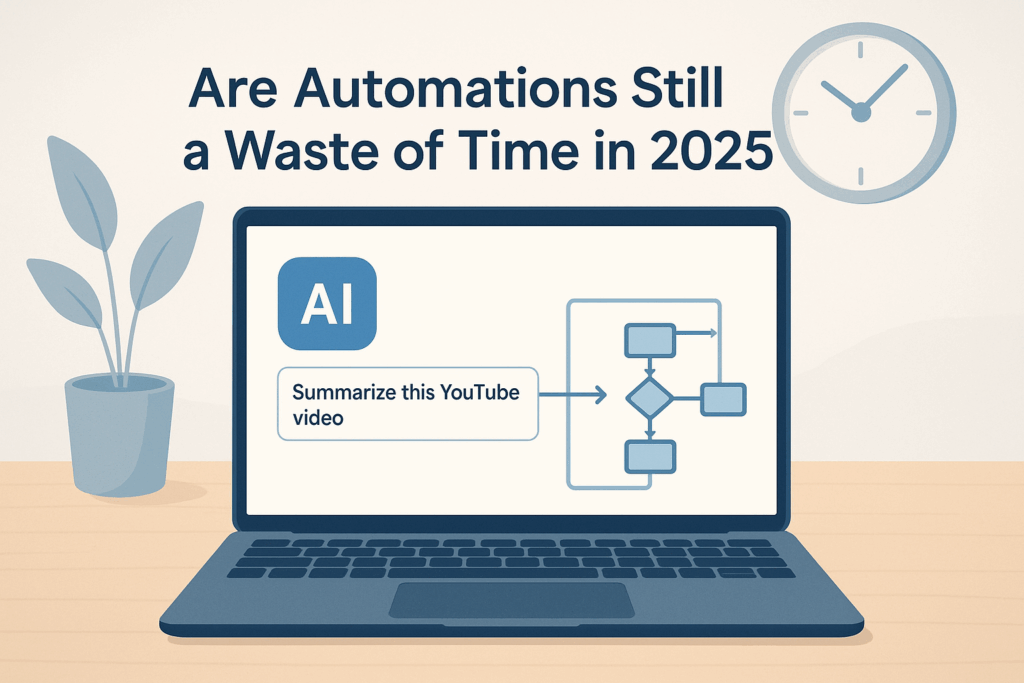A few months ago, I made a video explaining why I think most business automations are a waste of time. My main point was that people spend more time setting up automations than they actually save. That’s still true for complex automation platforms like n8n and Make.com.
But Google just released Opal, and it’s completely changed my perspective on simple automations. If you need to automate basic tasks quickly without technical expertise, the landscape just got much more interesting.
Table of Contents
ToggleWhy I Used to Say Automations Were a Waste of Time
Here’s what I’ve observed working with hundreds of small businesses: someone gets excited about automation, spends an entire day trying to automate a process in n8n or Make.com, and ends up with something that breaks constantly and saves maybe 10 minutes per week.
The math never worked. If you spend 8 hours building an automation that saves you 4 minutes per day, you need to run that automation for 120 days just to break even on your time investment.
Most automations fail because they’re too complex. Every step in the process depends on the previous step executing perfectly. Unless you’re automating something completely generic, you’ll struggle to get reliable output.
@tjrobertson52 I said automations were a waste of time. Then Google released Opal. 30 second setup vs 30 minute headache. Have you tried it? #GoogleOpal #Automation #ProductivityHack #TechTips #googlelabs
♬ original sound – TJ Robertson – TJ Robertson
Google Opal Changes the Game
Google Opal is a completely different approach to automation. Instead of connecting nodes and writing complex workflows, you just describe what you want in plain English.
I’ve used it to scrape and summarize content from webpages and YouTube videos. Tasks that would take me 30 minutes to set up in n8n take about 30 seconds in Opal.
How Google Opal Works
The process is simple:
- Go to opal.withgoogle.com and sign in with your Google account
- Describe your task in natural language (like “summarize this YouTube video”)
- Opal automatically generates the workflow steps
- Review and test the automation
- Run it whenever you need it
Opal is currently free during its beta phase, though it’s only available in the US right now.
When Automations Make Sense Now
With tools like Opal, automations finally make sense for these situations:
Quick, Repetitive Research Tasks
If you regularly need to summarize articles, extract key points from videos, or compile information from multiple sources, Opal can handle this in seconds rather than minutes.
Google-Centric Workflows
Since Opal integrates directly with Gmail, Google Drive, Calendar, and other Google services, it’s perfect if your business runs on Google Workspace.
Prototyping and Testing
Want to test whether an automation would be valuable? Opal lets you try it immediately instead of investing hours upfront.
Content Creation Support
I use it to quickly process research materials, extract quotes from interviews, and compile information for blog posts and client work.
When to Stick with Traditional Tools
Google Opal isn’t designed for complex business workflows. Here’s when n8n or Make.com still make more sense:
Enterprise-Grade Requirements
If you need advanced error handling, complex branching logic, or integration with dozens of third-party services, traditional platforms offer more control.
Mission-Critical Processes
Opal is still experimental and lacks the reliability features that business-critical workflows require.
Custom API Integration
Opal can’t connect to most custom APIs or databases. For complex integrations, you’ll need more powerful tools.
High-Volume Processing
If you’re processing thousands of transactions or handling large datasets, traditional automation platforms are better equipped.
The Future of Business Automation
We’re at a turning point. AI is making automation accessible to non-technical users while simultaneously making it more powerful for technical users.
My prediction: within two years, most simple automations will be handled by AI-powered tools like Opal, while complex automations will still require traditional platforms.
For small business owners, this means you should start with the simplest solution that works. Try Opal for basic tasks. Only move to more complex tools when you’ve proven the automation provides real value.
My Updated Automation Strategy
Here’s my current approach:
- Try Opal first for any automation that involves Google services or simple content processing
- Document the process before automating anything – if you can’t write clear steps, don’t automate it yet
- Measure the time savings to ensure the automation actually provides value
- Start small – automate one simple task before building complex workflows
The key is to match the tool to the complexity of the task. Don’t use a sledgehammer to hang a picture frame.
Ready to Optimize Your Marketing?
Automation is just one piece of an effective marketing strategy. If you want to see how AI and automation can improve your specific business processes, TJ Digital offer free digital marketing audits where I review your current systems and identify the highest-impact improvements.
The audit covers your website optimization, content strategy, and yes – automation opportunities that actually make sense for your business. No fluff, just actionable insights you can implement immediately.

